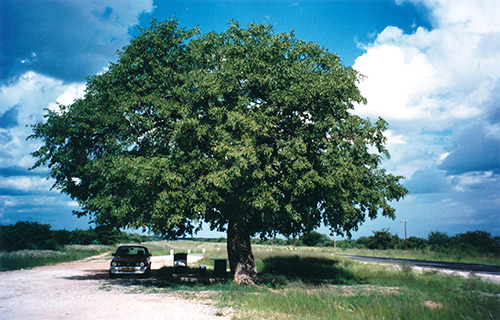SICKLE-SHAPED twin leaves resembling the wings of a butterfly are the most obvious characteristic of this tree, which is predominant in much of northwestern Namibia north of the Brandberg and to the west of Namutoni, especially around Halali.
Indeed, the Omusati region is named after this tree. Scattered Mopane trees occur around Nkurenkuru and then again in greater numbers in the eastern Zambezi region.
Names: G. & A. Mopane, E. also butterfly tree, turpentine tree; H., Nd. & Ky. Omusati N/D. !oenis; Bot. Colophospermum mopane.
Under favourable conditions the mopane will form a lush crown as on the photo. Mostly, however, it is a slender, V-shaped tree, about 5 – 12 m high, and is single-stemmed or divides into two or more stems near the ground. It has a few erect branches and a rather sparse, frequently flattened crown. This tree thrives in low-lying, hot, dry localities. Mopane can also cover large areas as dense, very monotonous scrub of 1 – 2 m height. There may be several reasons for this phenomenon: a lack of soil fertility, a lack of water, overgrazing or the excessive felling of these trees.
Grey and very rough, the trunk is characteristically fissured lengthways. The compound leaf consists of two sickle-shaped leaflets joined only at the base and similar in shape to the wings of a butterfly or the footprint of an antelope. The new leaves appearing from October onwards are of a lovely coppery to golden-yellow hue. This colour can be seen once more when the leaves sprout again after having been eaten by the mopane worm, creating the effect of ‘autumn in summer’. During hot weather the leaflets fold against each other and turn their narrow edges towards the sun, thus reducing the area from which moisture can evaporate. For this reason one searches in vain for a cool shady spot in a mopane forest on a hot day.
Inconspicuous, small, yellowish green flowers in hanging sprays appear from November to January. For reasons as yet unknown, large tracts of mopane woodland sometimes do not flower or bear fruit for several consecutive years.
Flat, kidney-shaped, light brown, leathery pods containing a single wrinkled seed are spotted with many shiny, sticky resinous glands. The botanical name “Colophospermum”, meaning ‘resinous seed’, refers to this resin, which also occurs in all the other parts of the tree. ‘Mopane’ is a common African name for this tree. The seeds are mainly dispersed by sticking to the hooves and feet of animals. Due to the high content of resin the mopane tree burns even when green, the pods burn like small candles and the wood is an excellent fuel.
The mopane is one of the trees most commonly used for the construction of traditional houses, palisades and fences in the regions Omusati, Oshana and Oshikoto. The trunks are usually straight and the hard heavy wood is immune to attack by termites and other insects. The tree coppices easily and can therefore be harvested for timber without killing the plant. The inner bark is used to tie the framework of huts and palisades. The outer bark is rich in tannin and leather tanned with it turns light brown.
* Find out more about this interesting tree in next week’s Thursday edition.
Stay informed with The Namibian – your source for credible journalism. Get in-depth reporting and opinions for
only N$85 a month. Invest in journalism, invest in democracy –
Subscribe Now!






